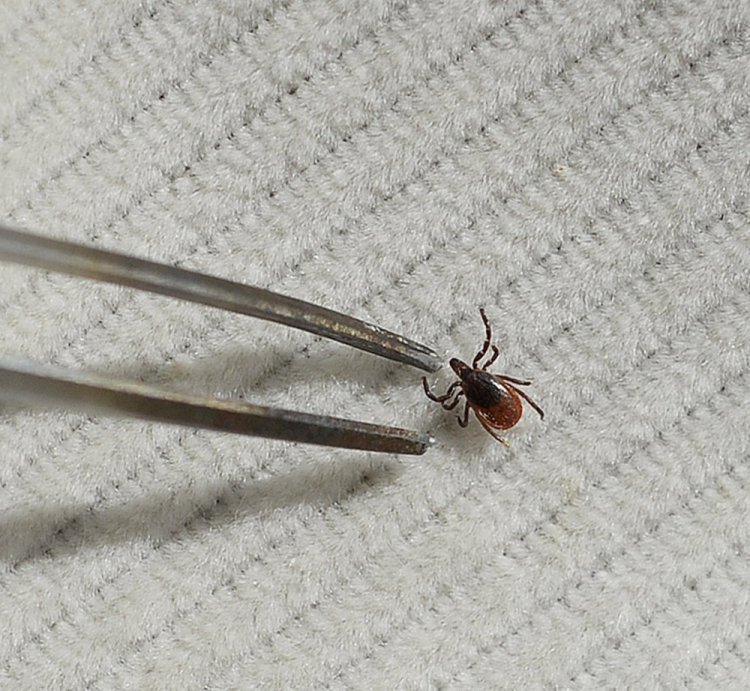Reported cases of Lyme disease reached an all-time high of 1,464 last year in Maine, according to the Maine Center for Disease Control and Prevention. That beat the previous high of 1,410 reported in 2014.
After a harsh winter in 2014-15 that might have knocked back the deer tick population, Lyme cases dipped slightly to 1,210 in 2015 before skyrocketing in 2016.
Lyme cases surged last fall after an extremely dry summer had caused ticks to be in a hibernation-like state, said Charles Lubelczyk, a field biologist with the Maine Medical Center Research Institute’s “tick lab.” Lyme cases were below five-year averages through July, according to the Maine CDC, before Lyme came roaring back in the fall.
 Lubelczyk said researchers at first weren’t sure whether the deer ticks, which transmit Lyme disease, had died or were merely dormant, because ticks do not thrive in dry weather. But when moist conditions returned in the fall, so did the ticks.
Lubelczyk said researchers at first weren’t sure whether the deer ticks, which transmit Lyme disease, had died or were merely dormant, because ticks do not thrive in dry weather. But when moist conditions returned in the fall, so did the ticks.
“When we did our field surveys in the fall, they were out in very high numbers,” Lubelczyk said. He said snow in March and early April this year may have caused ticks to become less active, but the snow also acts as an insulator, protecting the ticks. It takes extremely cold temperatures without snow on the ground for weeks at a time to kill ticks, he said, and that didn’t happen this past winter.
The institute is conducting a multiyear study about how deer ticks survive winter, and so far about 70 percent of the ticks in the study have survived the cold in southern Maine.
“We have had a far higher survival rate than we expected,” Lubelczyk said.
Now that the weather is turning warmer, the ticks should be out in force starting this week, he said.
“We don’t know how bad the ticks are going to be yet, but we’re going to have some pretty warm days over the next two to three weeks,” Lubelczyk said. “That’s going to open the doors wide open for them.”
The institute is expected to count tick populations and note their activity this week.
Lyme disease symptoms include fatigue, dizziness, swelling, joint and nerve pain, persistent headaches and flu-like symptoms.
Lyme can be treated with antibiotics, but many people don’t have immediate symptoms and don’t know they have contracted Lyme until later. Some people get a bull’s-eye rash that indicates Lyme disease, but many don’t get the rash.
 In most cases, a tick needs to be attached to a host for 36 to 48 hours before Lyme disease can be transmitted, according to the U.S. Centers for Disease Control and Prevention, so early detection is crucial.
In most cases, a tick needs to be attached to a host for 36 to 48 hours before Lyme disease can be transmitted, according to the U.S. Centers for Disease Control and Prevention, so early detection is crucial.
Paula Jackson Jones of Nobleboro, a Lyme disease activist, said the ticks are already noticeable.
“We’re already seeing them. They’re coming out big time,” said Jackson Jones, who has been in remission from chronic Lyme disease since 2014.
The deer tick’s range is expanding, Lubelczyk said, and his researchers are seeing more ticks Down East and in northern parts of the state than they did five to 10 years ago, as climate change takes hold.
Jackson Jones said ticks are here to stay, so activists are focusing on prevention, such as spraying property, wearing protective clothing, using repellents and being aware of tick habitat.
“We need to wrap the state in bubble wrap with prevention methods,” Jackson Jones said.
Angela Coulombe of Saco, also a Lyme disease activist, said she’s not at all surprised that Maine broke another Lyme disease record, because deer ticks are becoming more prevalent.
“People need to take the threat seriously,” Coulombe said. “When you’re out, take precautions.”
Send questions/comments to the editors.




Comments are no longer available on this story